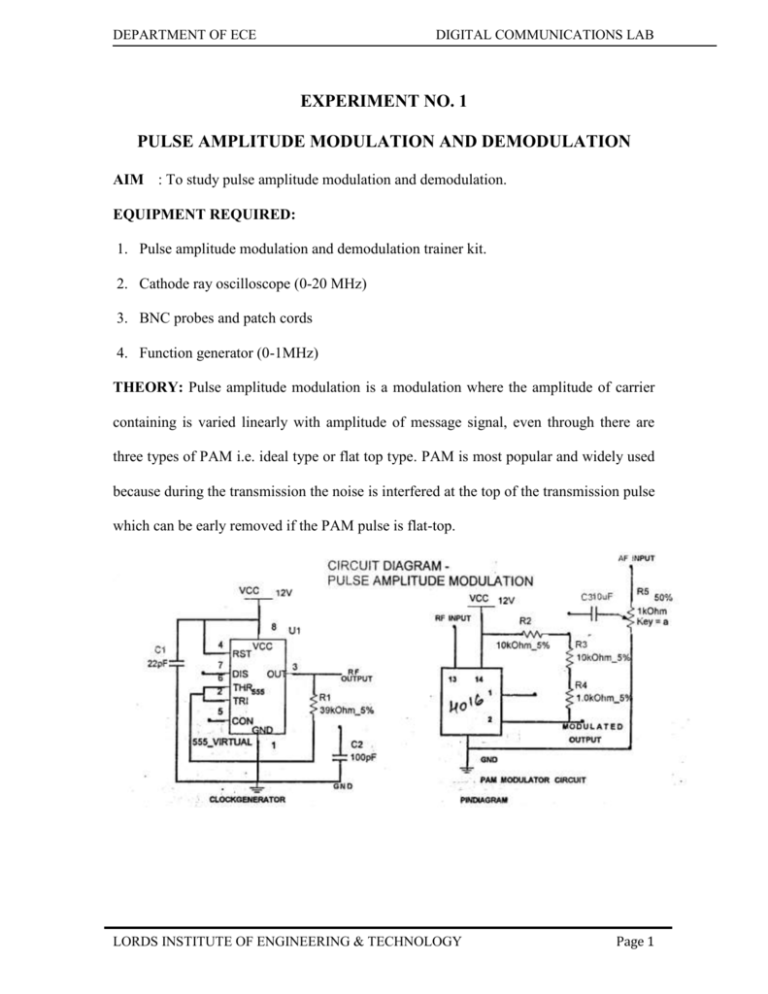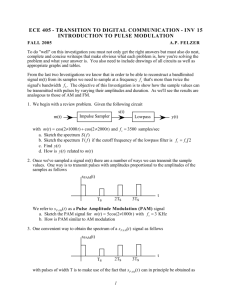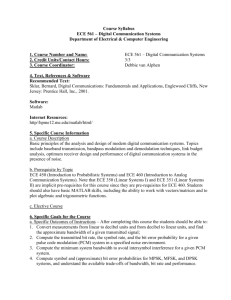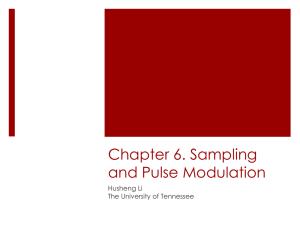(New)Analog Communication lab expts
advertisement

DEPARTMENT OF ECE DIGITAL COMMUNICATIONS LAB EXPERIMENT NO. 1 PULSE AMPLITUDE MODULATION AND DEMODULATION AIM : To study pulse amplitude modulation and demodulation. EQUIPMENT REQUIRED: 1. Pulse amplitude modulation and demodulation trainer kit. 2. Cathode ray oscilloscope (0-20 MHz) 3. BNC probes and patch cords 4. Function generator (0-1MHz) THEORY: Pulse amplitude modulation is a modulation where the amplitude of carrier containing is varied linearly with amplitude of message signal, even through there are three types of PAM i.e. ideal type or flat top type. PAM is most popular and widely used because during the transmission the noise is interfered at the top of the transmission pulse which can be early removed if the PAM pulse is flat-top. LORDS INSTITUTE OF ENGINEERING & TECHNOLOGY Page 1 DEPARTMENT OF ECE DIGITAL COMMUNICATIONS LAB PROCEDURE : 1. Switch on pulse amplitude modulation and demodulation trainer. 2. In clock generator section connect pin 6 of 555 IC to the 100pf capacitor terminal. 3. Check the clock generator (RF) output signal. 4. Connect RF output of clock generator to the RF input of modulator circuit. 5. Connect an AF signal with an arbitrary amplitude and frequency from function generator to the AF input of modulator section. 6. Short the 10f terminal and 10K terminal of modulator. 7. connect 10 K terminal to pin 1 of IC 4016. 8. Connect the CRO to modulated output of modulator section. 9. Adjust the 1kpotnetiometer to vary the amplitude of the modulated signal. 10. Adjust the AF and clock signal frequency and amplitude to get stable output wave form (such that clock frequency is very much grater than AF frequency). The output observed is single polarity PAM. LORDS INSTITUTE OF ENGINEERING & TECHNOLOGY Page 2 DEPARTMENT OF ECE DIGITAL COMMUNICATIONS LAB 11. During demodulation, connect the modulated output to the PAM. 12. During demodulation, connect the modulated output to the PAM input of demodulator section. 13. Connect channel 1 of CRO to modulating signal and channel – 2 to demodulated output. Adjust the AF signal frequency to observe the clear output. 14. observe the two wave forms that they are 1800 out of phase, since the transistor detector operates in CE configuration. OBSERVATIONS: SIGNAL PARAMETER TIME PERIOD AMPLITUDE(in (in seconds) volts) FREQUENCY (in Hz) X(t) S(t) Xd(t) LORDS INSTITUTE OF ENGINEERING & TECHNOLOGY Page 3 DEPARTMENT OF ECE DIGITAL COMMUNICATIONS LAB EXPECTED WAVE FORMS: RESULTS: PRECAUTIONS: 1. Check all the components and devices used in the circuit for its proper functioning. 2. Rig-up the circuit with utmost care and avoid loose connections 3. Check the circuit connection thoroughly before switching ON. 4. Handle the equipments carefully. 5. Operate the measuring instruments gently, as they are sensitive. 6. Switch off the supply when not in use. VIVA VOCE QUESTIONS: 1. Define pulse Amplitude Modulation 2. Give few appliation of PAM 3. Disccuss the Bandwidth requirements of PAM. LORDS INSTITUTE OF ENGINEERING & TECHNOLOGY Page 4 DEPARTMENT OF ECE DIGITAL COMMUNICATIONS LAB EXPERIMENT NO:2 PULSE WIDTH MODULATION AND DEMODULATION AIM : To study pulse width Modulation and Demodulation. EQUIPMENT REQUIRED: 1. Pulse width modulation and demodulation trainer. 2. Cathode ray oscilloscope (0-20 MHz) 3. BNC probes and patch cords 4. Function generator (0-1MHz) THEORY: In pulse width modulation, the signal to be transmitted as sampled as in pulse amplitude modulation. In pulse time modulation amp. Of pulse is of pulse is proportional to amp of signal at the sampling instant. Then we have two types of pulse time modulation. 1. PWM 2. PPM This is also know as pulse duration modulation (POM) the variations of pulse width modulation are pulse is held constant and change in pulse width with signal is measured with respect to the leading edge. LORDS INSTITUTE OF ENGINEERING & TECHNOLOGY Page 5 DEPARTMENT OF ECE DIGITAL COMMUNICATIONS LAB CIRCUIT DIAGRAM OF PULSE WIDTH MODULATION PROCEDURE: 1. Switch on pulse width modulation and demodulation trainer. 2. Apply clock and AF signal with an arbitrary frequency and amplitude by using function generator and connect them to the respective terminals of PWM modulation. 3. Observe the PWM output at pin 3 of 555 IC on CRO. LORDS INSTITUTE OF ENGINEERING & TECHNOLOGY Page 6 DEPARTMENT OF ECE DIGITAL COMMUNICATIONS LAB 4. By varying frequency and amplitude of the modulating signal, observe the corresponding change in the width of the output pulses. 5. during demodulation, connect PWM output of PWM modulation to the PWM input of PWM demodulation. Observe the demodulation output at AF signal of PWM demodulation on CRO. OBSERVATIONS: SIGNAL PARAMETER TIMEPERIOD FREQUENCY AMPLITUDE ( in (in seconds) (in Hz) volts) X(t) C(t) XPWM (t) (Diff. Pulsewidths) Xd(t) LORDS INSTITUTE OF ENGINEERING & TECHNOLOGY Page 7 DEPARTMENT OF ECE DIGITAL COMMUNICATIONS LAB EXPECTED WAVEFORM: AF SIGNAL ^ RESULTS LORDS INSTITUTE OF ENGINEERING & TECHNOLOGY Page 8 DEPARTMENT OF ECE DIGITAL COMMUNICATIONS LAB PRECAUATIONS: 7. Check all the components and devices used in the circuit for its proper functioning. 8. Rig-up the circuit with utmost care and avoid loose connections 9. Check the circuit connection thoroughly before switching ON. 10. Handle the equipments carefully. 11. Operate the measuring instruments gently, as they are sensitive. 12. Switch off the supply when not in use. VIVA VOCE QUESTIONS: 1. Define Pulse width Modulation 2. Give few applications of PWM. 3. Discuss the Bandwidth requirements of PWM. LORDS INSTITUTE OF ENGINEERING & TECHNOLOGY Page 9 DEPARTMENT OF ECE DIGITAL COMMUNICATIONS LAB EXPERIMENT NO.3 PULSE POSITION MODULATION AND DEMODULATION AIM : To study Pulse Position Modulation and Demodulation. EQUIPMENT REQUIRED: 1. Pulse position modulation and demodulation trainer. 2. Cathode ray oscilloscope (CRO) – (0.20MHz) 3. BNC probes and patch cords. 4. Function generator (0-1 MHz) THEORY : Pulse position modulation is one of the pulse time modulation scheme. In PPM the analog sample value determines the position of a naeron pulse relate to the clocking time. Techniques for generating PPM are also related and it is seen that PPM is easily obtained from PWM by a monostable multivibrator circuit in the literature on PPM systems. The comparator level V, is often called the slicing lead. PWM or PPM signals may be converted back to the corresponding analog signal by a receiving signal for PWM detection PWM signal is used to start and stop the integration of an integrator that is, the integrator is reset to zero because relatively wide band channel is needed especially for PPM. LORDS INSTITUTE OF ENGINEERING & TECHNOLOGY Page 10 DEPARTMENT OF ECE DIGITAL COMMUNICATIONS LAB CIRCUIT DIAGRAM: LORDS INSTITUTE OF ENGINEERING & TECHNOLOGY Page 11 DEPARTMENT OF ECE DIGITAL COMMUNICATIONS LAB PROCEDURE: 1. Switch on PPM modulator and demodulator trainer. 2. Apply clock and AF signal with an arbitrary frequency and amplitude by using function generator and connect them to pin 2 and pin 5 of 555 IC respectively. 3. Observe the PWM output across R2 resistor. 4. Observe the PPM output at pin 3 of second 555 IC on CRO and note down the PPM waveform w.r.t. PWM and clock signal. 5. Connect the PPM output to the PPM input of demodulation. 6. Observe the demodulated output on CRO. OBSERVATIONS: SIGNAL X(t) C(t) XPWM(t) XPPM(t) Xd(t) Amplitude (in volts) Timperiod (in seconds) Frequency (in Hz) LORDS INSTITUTE OF ENGINEERING & TECHNOLOGY Page 12 DEPARTMENT OF ECE DIGITAL COMMUNICATIONS LAB RESULTS: PRECAUTIONS: 1) Check all the components and devices used in the circuit for its proper functioning. 2) Rig-up the circuit with utmost care and avoid loose connections LORDS INSTITUTE OF ENGINEERING & TECHNOLOGY Page 13 DEPARTMENT OF ECE DIGITAL COMMUNICATIONS LAB 3) Check the circuit connection thoroughly before switching ON. 4) Handle the equipments carefully. 5) Operate the measuring instruments gently, as they are sensitive. Switch off the supply when not in use. VIVA-VOCE QUESTIONS: 1. Define Pulse position modulation 2. Give few applications PPM. 3. What are the Bandwidth requirements of PPM. 4. Compare PAM, PWM and PPM. LORDS INSTITUTE OF ENGINEERING & TECHNOLOGY Page 14 DEPARTMENT OF ECE DIGITAL COMMUNICATIONS LAB EXPERIENCE NO.4 SAMPLING THEOREM - VERIFICATION AIM : To study and verify the sampling theorem and reconstruction of sample waveform. EQUIPMENT REQUIRED: 1. Verification of sampling theorem trainer kit. 2. Function generator (0 – 1 MHz) 3. Cathode ray oscilloscope (CRO) (0-20MHz) 4. BNC probes and patch cords. THEORY: Sampling process is used to convert analog signal to digital form initially it is converted to discrete signal. It is done by a process called sampling. After defined at discrete time interval and hence discontinuous signal formed basically sampling involves the multiplication of base band signal with an impulse train which is periodic with period. TS in continuous ware modulation some parameters of modulation ware varied continuous with the message signal and we have two types of sampling. 1. Natural sampling 2. Flat top sampling LORDS INSTITUTE OF ENGINEERING & TECHNOLOGY Page 15 DEPARTMENT OF ECE DIGITAL COMMUNICATIONS LAB CIRCUIT DIAGRAM: 10kΩ_5% 10KΩ 10kΩ_5% 10kΩ_5% PIN DIAGRAM ICLM324 PROCEDURE: 1. Connection are made as per the circuit diagram. 2. Apply the modulating signal with an arbitrary frequency (fm) and amplitude using function generator. LORDS INSTITUTE OF ENGINEERING & TECHNOLOGY Page 16 DEPARTMENT OF ECE DIGITAL COMMUNICATIONS LAB 3. Sampling clock signal with a variable frequency should be connected across the terminals which is indicated on the kit (or) by using function generator. 4. Now observe the sampling output of the circuit at the output terminal by adjusting the amplitude and frequency of modulating and clock signal (amplitude of modulating signal is limited to 6V p-p). 5. By using capacitors and resistors provided on the trainer, reconstruct the signal and verify it with the given input. 6. Reconstructed signal voltage will be depends on capacitor value. 7. Vary the sampling frequency and study the change in reconstructed signal. 8. If the sampling clock frequency (fs) is below 2fm where fm is the modulating frequency, the distorted outputs is observed. (Note: for clear output take modulating signal of high frequency during sampling (<<fs) and low frequency during reconstruction). OBSERVATION: SIGNAL PARAMETER TIMEPERIOD FREQUENCY AMPLITUDE ( in (in seconds) (in Hz) volts) X(t) S(t) Xd(t) LORDS INSTITUTE OF ENGINEERING & TECHNOLOGY Page 17 DEPARTMENT OF ECE DIGITAL COMMUNICATIONS LAB RESULTS: PRECAUTIONS: 1. Check all the components and devices used in the circuit for its proper functioning. 2. Rig-up the circuit with utmost care and avoid loose connections 3. Check the circuit connection thoroughly before switching ON. 4. Handle the equipments carefully. 5. Operate the measuring instruments gently, as they are sensitive. 6. Switch off the supply when not in use. LORDS INSTITUTE OF ENGINEERING & TECHNOLOGY Page 18 DEPARTMENT OF ECE DIGITAL COMMUNICATIONS LAB VIVA-VOCE QUESTIONS: 1. State sampling theorem 2. Explain under sampling, critical sampling and oversampling 3. Define Nyquist rate 4. What are the effects of undersampling LORDS INSTITUTE OF ENGINEERING & TECHNOLOGY Page 19 DEPARTMENT OF ECE DIGITAL COMMUNICATIONS LAB EXPERIMENT NO.:5 TIME DIVISION MULTIPLEXING AIM : To verify the operation of Time – Division Multiplexing. EQUIPMENT REQUIRED: 1. Time-division multiplexing and de-multiplexing trainer. 2. Cathode Ray Oscilloscope (CRO) – (0.20MHz) 3. BNC probes and patch cords. THEORY : Analog time division multiplexing (digital) as the number of message to be transmitted increases, the frequency division techniques. The number of sub carries needed increases and stabilses of which problem can rise. Additional circuit is record (or) required at both side is transmitting and receiving ends to handle each added channel. The band width requirement increases directly with number of channels. These problems are eliminated to guest extent by using time division multiplexing together with pulse modulation. In TDM each intelligence is said to be transmitted is sampled sequentially and the resulting pulse code is used to modulate the carrier the same carrier frequency is used to transmit different pulse sequentially one after another each intelligence to transmitted has been allotted a given time slot only or small modulates the carrier at any time no added equipment and no increase in bandwidth is need when multiplexing in bandwidth is need when multiplexed. The number of sequential channel that can be handled is limited. LORDS INSTITUTE OF ENGINEERING & TECHNOLOGY Page 20 DEPARTMENT OF ECE DIGITAL COMMUNICATIONS LAB CIRCUIT DIAGRAM: PROCEDURE : 1. Switch on time division multiplexing and de multiplexing trainer. 2. Observe the individual waveform on channel 1 of CRO and notedown the corresponding amplitude and frequency. 3. Connect the sine wave to CH1, square wave to CH2 and triangular wave to CH3 terminal of 8 to 1 MUX. 4. Observe the multiplexer output on channel 1 of CRO. 5. Connect MUX output to DEMUX input. 6. Observe the corresponding signal outpu’s at channel 2 of CRO. 7. Repeat the above steps by applying different inputs using function generator. LORDS INSTITUTE OF ENGINEERING & TECHNOLOGY Page 21 DEPARTMENT OF ECE DIGITAL COMMUNICATIONS LAB OBSERVATIONS: SIGNAL Amplitude (in volts) Timperiod (in seconds) Frequency (in Hz) X(t) C(t) XPWM(t) XPPM(t) Xd(t) X LORDS INSTITUTE OF ENGINEERING & TECHNOLOGY Page 22 DEPARTMENT OF ECE DIGITAL COMMUNICATIONS LAB OBSERVATIONS: SIGNAL Amplitude (in volts) Timperiod (in seconds) Frequency (in Hz) X(t) C(t) XPWM(t) XPPM(t) Xd(t) RESULTS: PRECAUTIONS: 1. Check all the components and devices used in the circuit for its proper functioning. 2. Rig-up the circuit with utmost care and avoid loose connections 3. Check the circuit connection thoroughly before switching ON. 4. Handle the equipments carefully. LORDS INSTITUTE OF ENGINEERING & TECHNOLOGY Page 23 DEPARTMENT OF ECE DIGITAL COMMUNICATIONS LAB 5. Operate the measuring instruments gently, as they are sensitive. 6. Switch off the supply when not in use. VIVA-VOCE QUESTIONS: 1. Explain Time Division Multiplexing 2. Name few applications of TDM 3. Compare TDM with FDM. LORDS INSTITUTE OF ENGINEERING & TECHNOLOGY Page 24 DEPARTMENT OF ECE DIGITAL COMMUNICATIONS LAB Expt No. 12 PULSE DURATION MODULATION USING MONOSTABLE MULTIVIBRATOR AIM: To produce pulse duration modulation using Monostable multivibrator. EQUIPMENT REQUIRED: DC Power supply, IC74121, Thermistor, Capacitor 2200pF, Pulsar. THEORY: Pulse modulation is widely used in digital communications. In this type of modulation, the information to be transmitted in converted into pulses of various sizes and shapes and then transmitted to appropriate stations. The process of converting data into pulses can be carried out in a variety of ways and is called encoding. Three of the most common types of encoding or modulation are discussed here. In pulse amplitude modulation or PAM, the data controls the height of the pulse while in PDM or pulse duration modulation, the pulse width is proportional to the data value. Pulse position modulation or PPM is the process in which the position of a pulse with respect to a reference pulse is proportional to the data value. These processes are illustrated in Fig.(1). The essential difference between pulse modulation and the conventional AM or FM is that in AM or FM some parameter of the carrier wave varies continuously by the information, whereas in pulse modulation some parameter of a pulse is varied by the sampled message. The pulses are usually of very short duration and as such a pulse modulator is ‘OFF’ most of the time, i.e., low duty cycle. The low duty cycle operations coupled with the facility of utilization of the time interval between two consecutive pulses of a particular message for transmitted other messages makes pulse modulation superior to AM or FM. LORDS INSTITUTE OF ENGINEERING & TECHNOLOGY Page 25 DEPARTMENT OF ECE DIGITAL COMMUNICATIONS LAB The PDM and PPM systems are not usually as susceptible to noise as a PAM system. Figure 3 shows a simple circuit to produce PDM. It is a monostable multivibrator with thermistor as an element that controls the width of the output pulse. As a result, the output pulse width varies in accordance with the temperature of the thermistor, i.e., output is pulse width modulated. One can obtain PPM by differentiating and rectifying the PDM signals. Fig.3: PDM using a monostable multivibrator LORDS INSTITUTE OF ENGINEERING & TECHNOLOGY Page 26 DEPARTMENT OF ECE DIGITAL COMMUNICATIONS LAB PROCEDURE: 1. Rig up the circuit as per the circuit diagram. 2. Pulses are given at Pin 4. 3. Observe the waveform at Q. 4. Plot the Pulse duration waveforms. LORDS INSTITUTE OF ENGINEERING & TECHNOLOGY Page 27 DEPARTMENT OF ECE DIGITAL COMMUNICATIONS LAB Expt No. 13 GENERATION OF PDM AND PPM USING PLL AIM: To generate Pulse duration modulation and Pulse Position modulation waveform using Phase Lock Loop. EQUIPMENT REQUIRED: (1) CRO (2) Audio oscillator (3) Square-wave generator (15 kHz) (4) ICs: 565, 7486 with bases, Transistor 2N2222 (5) Dual power supply (6-0-6V) (6) Capacitors and resistors. THEORY: The PLL can be used to produce PDM and PPM with the help of the circuit shown in Fig.1. The phase-locked loop remains locked if the VCO input remains constant such that fi = fo = fo’. the modulating signal applied to pin 7 (input of VCO) upsets this equilibrium. This causes the phase detector output to change in order to maintain the VCO input at this level. A change in the output of the phase detector means a change in the phase difference between its two input signals. Thus, the VCO output has a phase shift proportional to the modulating signal amplitude, i.e., it is pulse position modulated. This signal is amplified by T before using the same for some purpose. LORDS INSTITUTE OF ENGINEERING & TECHNOLOGY Page 28 DEPARTMENT OF ECE DIGITAL COMMUNICATIONS LAB Fig.1: Generation of PDM and PPM using PLL The input signal and the PPM constitute the two inputs of the exclusive OR gate. It compares the PPM signal and the original pulse leading to production of PDM at twice the frequency of the original signal, The centre frequency of the VCO is adjusted by R3 while R4 may be adjusted to control the duty cycle of PDM signal. EXPERIMENTAL PROCEDURE 1. Wire the circuit as shown in Fig.1. 2. Use the square-wave generator to feed the input signal vc (pin2) at about 15 kHz. 3. Use the audio oscillator as the source of modulating voltage (200 Hz to 2 kHz). 4. Adjust R3 such that the free-running frequency of the VCO is close to the input signal frequency. 5. Monitor PDM and PPM outputs using CRO. LORDS INSTITUTE OF ENGINEERING & TECHNOLOGY Page 29 DEPARTMENT OF ECE DIGITAL COMMUNICATIONS LAB 6. Vary the modulating signal frequency and observe (a) pulse width of PDM and (b) pulse position in PPM. Questions 1. What is pulse modulation? How is it different form AM or FM? 2. What are the advantages of pulse modulation? 3. Distinguish between PAM, PDM and PPM. 4. Explain how a PLL can be used to generate PPM and PDM. LORDS INSTITUTE OF ENGINEERING & TECHNOLOGY Page 30







